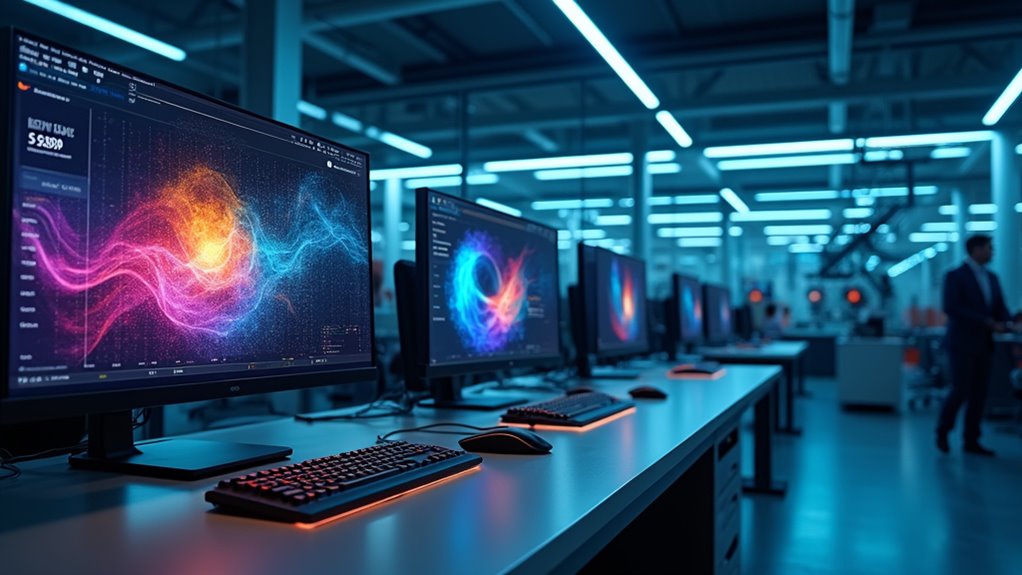Companies across industries are leveraging generative AI to boost productivity and innovation. Adobe enhances Photoshop with Firefly, while Virgin Voyages creates personalized customer experiences. In manufacturing, EOT’s Twin Talk GPT predicts machine failures before they happen. Healthcare firms like Cradle revolutionize drug discovery, and financial giants such as Citi improve customer service with AI. With every $1 invested yielding $3.70 in return, businesses that don’t adopt this technology risk falling behind the competition. The transformation is just beginning.

While businesses have always sought ways to boost efficiency, generative AI has emerged as the transformative technology that’s reshaping how companies operate across industries. The rapid adoption of these AI Innovations isn’t just hype—it’s delivering real results.
Adobe, for instance, has supercharged its Creative Cloud suite with Adobe Firefly, making complex image editing tasks in Photoshop practically effortless. Meanwhile, BMW is analyzing mountains of enterprise data for strategic insights that were previously impossible to extract.
These Generative Applications aren’t limited to tech giants. Virgin Voyages created personalized cruise invitations featuring Jennifer Lopez that made customers feel special, not spammed. Carrefour deployed their Marketing Studio using Vertex AI to streamline campaigns across social networks—because who has time for manual content creation anymore?
Generative AI democratizes personalization—making customers feel individually valued without drowning teams in manual content creation hell.
PODS generated over 6,000 unique billboard headlines in New York City using Gemini. Marketers, rejoice! These tools are freeing up about 5 hours weekly that you can use for, I don’t know, actual creative thinking?
In manufacturing, EOT’s Twin Talk GPT combines generative AI with edge computing for predictive maintenance. Translation: machines tell you they’re breaking before they break. Revolutionary, right?
Healthcare organizations aren’t being left behind either. Cradle uses Google Cloud’s generative AI to design proteins for drug discovery, while Recursion Pharmaceuticals invests in AI startups to develop novel drug candidates from limited datasets. This application exemplifies how predictive analytics is fundamentally enhancing healthcare diagnostics and treatment development.
Financial institutions like Citi are enhancing customer service with Vertex AI, and Hiscox employs BigQuery for AI-enhanced underwriting models. McKinsey estimates that generative AI could add up to $4.4 trillion annually to the global economy across various sectors. The telecom sector is equally enthusiastic, with SK Telecom developing an AI chatbot called A. that integrates services from music streaming to e-commerce.
A recent study by IDC confirms the business value, finding that every $1 investment in generative AI technology yields $3.70 in return. The message is clear: adopt generative AI or risk falling behind. Companies across sectors are using this technology to automate tasks, personalize experiences, and gain competitive advantages.
Those 5 hours saved weekly in marketing? Multiply that across departments, and you’ll understand why this isn’t just another tech trend—it’s a business revolution.
Frequently Asked Questions
How Can Small Businesses Implement Generative AI Affordably?
Small businesses can implement generative AI affordably through several approaches.
Free or low-cost effective tools like Canva and ChatGPT offer AI features without breaking the bank—most businesses spend only about $1,800 annually on AI.
Strategic partnerships with tech companies can provide discounted access to premium AI solutions.
Pre-trained models eliminate costly custom development, while user-friendly interfaces mean no coding expertise required.
Focus AI investments on high-ROI areas like marketing and customer service for maximum impact.
What Privacy Concerns Exist When Adopting Generative AI Solutions?
Privacy concerns when adopting generative AI include inadequate data security practices, lack of user consent mechanisms, and ethical considerations around data usage.
Companies must navigate compliance regulations like GDPR and CPRA, which demand transparency requirements in data handling. Additionally, bias mitigation remains challenging as training data may contain hidden prejudices.
How Long Does Implementing Generative AI Typically Take?
Implementing generative AI isn’t a weekend project, folks. The typical implementation timeline spans 6-12 months from planning to deployment.
Organizations face development challenges at every stage: weeks of planning, months of data preparation (often the biggest time-sink), several months of model development, and finally, deployment and integration.
Technical complexity, data quality issues, and stakeholder alignment can extend this timeline considerably.
What Skills Do Employees Need to Work With Generative AI?
Working with generative AI requires both technical and soft skills.
Data literacy tops the list—employees must understand how to prepare, analyze, and interpret data that feeds these systems.
Critical thinking helps evaluate AI outputs for accuracy and relevance.
Creative problem solving enables workers to leverage AI capabilities in innovative ways.
Communication skills become essential when collaborating across teams.
Ethical awareness matters too; knowing when and how to apply AI responsibly prevents misuse.
Adaptability remains vital as these technologies rapidly evolve.
How Do Companies Measure ROI From Generative AI Investments?
Companies measure ROI from generative AI investments through a multi-pronged approach. Key ROI metrics include cost reduction from automated tasks, revenue growth, time-to-market improvements, and customer satisfaction scores.
Smart investment strategies involve detailed planning with clear goals, regular impact analysis, and A/B testing to isolate AI’s contribution. Measuring intangible benefits remains tricky, folks!
Companies must establish solid benchmarks before deployment and use both financial and non-financial indicators to truly capture generative AI’s value.









